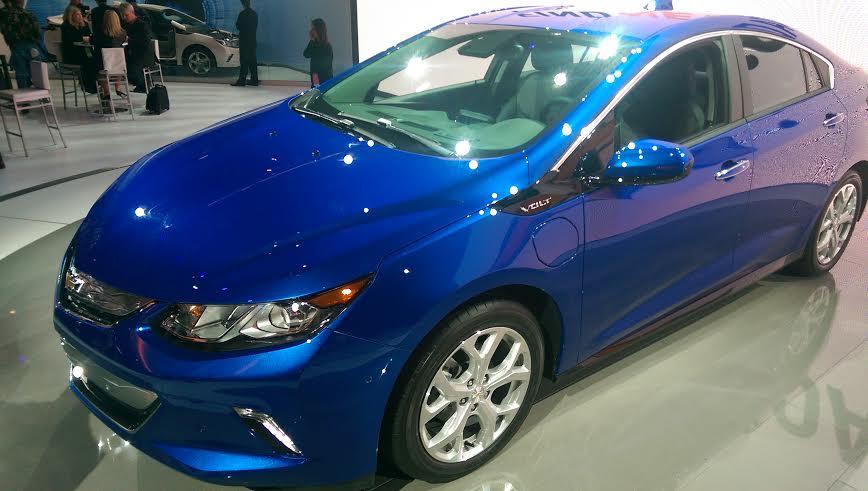
One of the first items on General Motors’ agenda during the 2015 North American International Car Show (NAIAS) was to reveal the 2016 Chevy Volt.
The Chevrolet exhibit at Cobo Hall in Detroit was packed, with the floor teeming with everyone from the leading news organizations to bloggers with their selfie sticks in hand. The cobalt blue Volt that emerged on stage did not disappoint, as CEO Mary Barra and North American President Alan Batey touted the 2016 model’s new features while at least 50 enthusiastic Volt owners cheered from their front row seats.
In previous years, rollouts of electric vehicles (EVs) and plug-in hybrids such as the Volt emphasized range and car battery features, which were well received by EV enthusiasts but met by a collective shrug and disinterest by most consumers. But that is slowly changing as EVs continue to improve their range as well as overall performance, and as such the 2016 Volt met expectations. The newest Volt is sleeker, yet still sports a hearty, muscular design. It is in many ways more efficient than earlier models, which of course will interest EV fans and inspire debate. But many of the new features and improvements were what one would expect to hear in a conventional gasoline-powered car — which in the end boosts the Volt’s performance and will score more interest from consumers.
The new Voltec propulsion system is the biggest difference for the latest Volt, which boasts stronger acceleration, more efficient driving and a longer all-electric driving range. At a time when cheap gasoline tempts many drivers to go for a bigger car or truck, the 2016 Volt is surprisingly bigger in many ways.
This next-gen Volt is more powerful, thanks to a 1.5-liter, four-cylinder, all-aluminum engine that offers a quieter ride and more oomph than the three-cylinder engines in previous models. The battery pack is also more efficient: It’s smaller with 96 less cells, but it offers 18.4 kilowatt-hours of power, is arranged within two packs instead of three, weighs 20 pounds less and is located lower in the car’s frame — improving the Volt’s center of gravity and allowing for a fifth person in that rear middle seat (though if that were me, my knees would be jammed to my chin).
The result is 50 miles of all-electric range, a 25 percent improvement from earlier Volts. GM claims the new car’s total driving range is 400 miles, and that owners can expect to drive about 1,000 miles between fill-ups, up from 850 to 900 in previous models. Volt drivers, who love the fact they rarely have to go to the gas station, can now buy unleaded, 87-octane gasoline — previous models required premium fuel only. Charging the battery will also be more seamless because the car’s GPS system allows drivers to set a “home charging” level (eight or 12 amps) and choose what time they want to start recharging, as in off-peak hours.
The Volt’s two electric motors also address the criticism often lobbed at EVs: They require far less rare earth metals. In fact, one of the motors has no rare earth minerals sourced from China. The GM engineers who spoke to us at the show said they reduced the total amounts of these minerals by almost two-thirds, from 7 to 2.5 total pounds within the 2016 Volt. Improvements in the motor’s design and gearing allow zero-to-30 mph acceleration, which is 19 percent stronger than in previous Volts.
Add the fact that the dash is more intuitive and has better illumination, and the latest Volt could turn more heads when it is released later this year. If the newest Volt meets all of the promises we heard in Detroit, a car once sniffed at as a passing fad could gain even more acceptance -- and make it easier for the future all-electric Bolt to gain acceptance with the fickle American driver.
Image credits: Leon Kaye
Based in California, Leon Kaye has also been featured in The Guardian, Clean Technica, Sustainable Brands, Earth911, Inhabitat, Architect Magazine and Wired.com. He shares his thoughts on his own site, GreenGoPost.com.
Disclosure: GM covered the cost of Leon Kaye’s attendance at NAIAS.

Leon Kaye has written for 3p since 2010 and become executive editor in 2018. His previous work includes writing for the Guardian as well as other online and print publications. In addition, he's worked in sales executive roles within technology and financial research companies, as well as for a public relations firm, for which he consulted with one of the globe’s leading sustainability initiatives. Currently living in Central California, he’s traveled to 70-plus countries and has lived and worked in South Korea, the United Arab Emirates and Uruguay.
Leon’s an alum of Fresno State, the University of Maryland, Baltimore County and the University of Southern California's Marshall Business School. He enjoys traveling abroad as well as exploring California’s Central Coast and the Sierra Nevadas.














